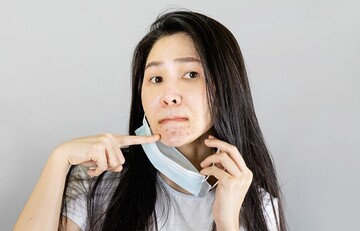The Causes of Maskne and 6 Ways to Prevent it
Posted by Samantha H on 27th Sep 2020
The face mask has recently become a crucial part of our everyday life since the outbreak of the coronavirus pandemic. However, many people wearing a face mask daily are experiencing an undesirable side effect: mask-induced acne, otherwise known as "maskne".
What causes Maskne?
In simple terms, maskne is acne appearing on skin areas in direct contact with the face mask, as it blocks our skin from outside contact, causing pressure, heat, and friction, which ultimately leads to irritation, inflammation, and acne.

Face masks create a perfect environment for breakouts to occur because sweat, oil, and bacteria are being trapped on your skin’s surface. Healthcare staff and other front-line workers are at a greater risk because their masks are more closely fitted, and they wear them for longer periods of time. In fact, a recent study among first-line health care workers in Hubei, China found that 97% developed skin damage because of wearing the face mask.
This type of acne is also referred to as acne mechanica, which is different from breakouts caused by hormonal or hereditary issues like cystic acne. Maskne is commonly occurs in areas such as the nasal bridge, cheeks, and chin. If the maskne is neglected and not addressed correctly, the skin will soon be covered with unwanted blemishes, which will become even more difficult to treat. A thorough, yet simple skincare regimen can help to prevent maskne and keep your skin looking beautiful.
Are you suffering from breakouts because of wearing the face mask? Read on for some simple tips on how to effectively manage it.
1. Keep your skin clean by using gentle cleansers
The first step in effectively preventing maskne is to keep your face clean using gentle cleansers. Double cleansing in the evenings is important to remove the excess sweat and skin buildup. This involves gently massaging an oil cleanser onto dry skin, using a small amount of water to emulsify the oil, rinsing it off thoroughly, and then following with a water-based cleanser (with a pH of 5.5, which is the ideal pH since cleansers with a higher pH tend to be harsher on the skin).
Product recommendations: Purito Defence Barrier pH Cleanser and Purito From Green Cleansing Oil.
Avoid harsh cosmetics, toners, or exfoliators that can aggravate irritation and inflammation.
2. Keep your skin hydrated with a lightweight moisturiser
Apply a light and non-greasy moisturiser after washing the face to reduce dryness and restore the skin's natural protective layer. It is important to keep the skin hydrated but without clogging the pores.
Product recommendation: Purito Oat-In Calming Gel Cream.
3. Maintain mask hygiene and choose the right material for your skin
An allergy to any of the materials found in the face mask can cause irritation. Choosing a breathable, hypoallergenic fabric can help to prevent this. Dermatologists recommend 100% cotton since it can allow your skin to breathe a little more than other materials.
If you use a fabric mask, be sure to wash it every day in warm water, use a gentle fragrance-free laundry detergent and allow it to dry completely before wearing again. If you wear a disposable mask, change it as often as possible to prevent oil and sweat from pilling up, or allow it to dry out between uses. It is recommended to change your face mask 3 times a day.
4. Avoid wearing heavy makeup
Makeup covering the skin, particularly foundation/BB cream can lead to clogged pores and breakouts due to the increased humidity under the mask. Keeping the pores clean is necessary and wearing heavy makeup would only trigger breakouts.
5. Use sunscreen daily
Masks are no replacement for sunscreen. A typical fabric facemask provides you with no more than SPF 7 sun protection. Therefore, a good sunscreen needs to be applied liberally all over the face and neck to protect the skin from harmful UV rays, and to prevent melasma (hyperpigmentation).
Product recommendation: The W.Skin Laboratory Triple Care Sun Cream SPF50+ PA++++ is one of the best sunscreens you can use to protect your skin from the harmful effects of the sun!
6. Use skincare products that target acne
Use products that are specifically formulated to treat blemishes when applying your skincare at night.
Treat individual pimples with spot treatments
Apply spot treatments to help keep pimples at bay. The classic spot treatment is the pimple patch. These are usually made of a hydrocolloid material that assists in rapidly healing pimples overnight. Try the SOME BY MI Clear Spot Patch 18pcs or the I’m from Mugwort Spot Gel.
Use calming ingredients, such as Centella asiatica, mugwort, tea tree oil and propolis
Using products with ingredients notable for their anti-inflammatory properties such as niacinamide or Centella asiatica (also known as tiger grass) can help in the prevention of acne and unwanted breakouts. Applying a calming sheet mask at least once a week can keep those pesky bumps under control.
Product recommendations:
Klairs Midnight Blue Calming Sheet Mask
Beauty of Joseon Centella Asiatica Calming Sheet Mask 10-pack
iUNIK Propolis Vitamin Synergy Serum
iUNIK Propolis Vitamin Sleeping Mask
Maskne can be a distressing skin condition to deal with. However, the above skincare tips can help you to soothe irritation and to keep your skin clear, radiant and healthy.

